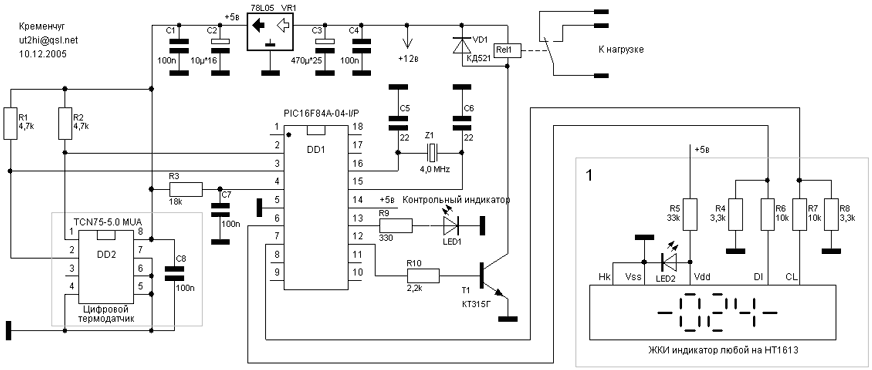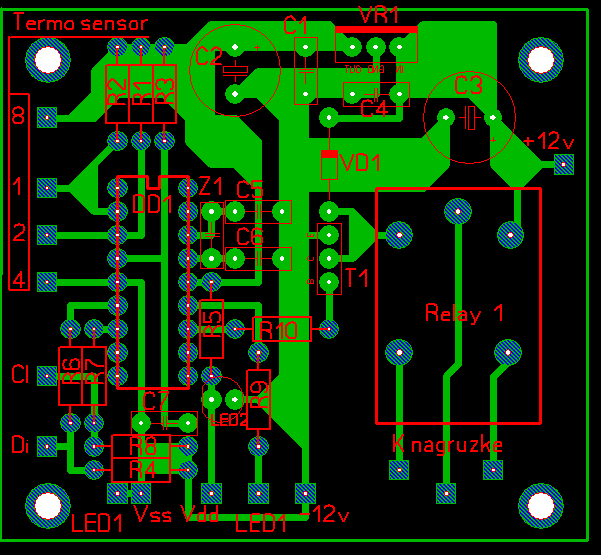Thermal relay on a microcontroller with a digital temperature sensor. Encyclopedia of radio electronics and electrical engineering

Encyclopedia of radio electronics and electrical engineering / Microcontrollers
 Comments on the article
Comments on the article
Thermal sensors are widely used in various areas of electronics. These are thermometers, fire alarm sensors, temperature monitoring of electronic equipment - amplifiers, power supplies, various converters, temperature protection of electronic devices, process control, etc. Both analog and digital sensors are used. The advantage of digital sensors is that the additional error of the measuring channel is eliminated, i.e. data from the sensor is taken already in a "ready" form, the ability to combine several sensors into a network for multi-zone measurement, which simplifies switching. Using the standard i2c bus as an interface greatly simplifies docking with other equipment.
In the described design of a simple thermal relay, an inexpensive digital temperature sensor of the Microchip company, type TCN75-5,0, is used. Small size, low cost and ease of use make the TCN75 ideal for integration into a variety of automation applications. The thermometer is designed to operate in the temperature range from -55 to +125 degrees, has a resolution of 0,5 degrees, measurement accuracy at a supply voltage of 5,0 volts 1 degree, which is ideal for these purposes. The thermal relay turns on the relay when the temperature drops below 19 degrees and turns it off when the temperature is above 23 degrees (room heater, it is possible to change the temperature of the relay operation).
The schematic diagram is shown in Fig. 1. The widely used PIC16F84A is used as a control microcontroller. LED indicator LED1 is designed to indicate the operation of the device. (blinks during operation) Relay P1 must be designed for a voltage of 12 volts and have contacts designed for switching loads. The node in the diagram of Fig. 1, designated as "1", can be temporarily installed to control the temperature and performance of the device after manufacture. The LCD will display the temperature in the middle from 0 degrees to +125 degrees. It is not required for further work.

Rice. 1 (click to enlarge)
To repeat this design, it is necessary to program the PIC16F84A microcontroller with firmware, which can be downloaded here.
Configuration bits: _XT_OSC _PWRTE_ON _CP_OFF _WDT_ON. Signet drawing in SprintLayout 4.0 format can be downloaded here.
Documentation (Datashit) for MK PIC16F84A
HEX firmware, as well as a drawing of the board, you can download here (17 kb).

Fig. 2
For controller firmware, please contact the author.
The author accepts orders for the manufacture of devices for individual orders, and also sends programmed controllers complete with a printed circuit board to repeat published designs.
Author: Yakimenko Sergey, UT2HI; Publication: ut2hi.qrz.ru
 See other articles Section Microcontrollers.
See other articles Section Microcontrollers.
 Read and write useful comments on this article.
Read and write useful comments on this article.
<< Back
 Latest news of science and technology, new electronics:
Latest news of science and technology, new electronics:
Air trap for insects
01.05.2024
Agriculture is one of the key sectors of the economy, and pest control is an integral part of this process. A team of scientists from the Indian Council of Agricultural Research-Central Potato Research Institute (ICAR-CPRI), Shimla, has come up with an innovative solution to this problem - a wind-powered insect air trap. This device addresses the shortcomings of traditional pest control methods by providing real-time insect population data. The trap is powered entirely by wind energy, making it an environmentally friendly solution that requires no power. Its unique design allows monitoring of both harmful and beneficial insects, providing a complete overview of the population in any agricultural area. “By assessing target pests at the right time, we can take necessary measures to control both pests and diseases,” says Kapil ... >>
The threat of space debris to the Earth's magnetic field
01.05.2024
More and more often we hear about an increase in the amount of space debris surrounding our planet. However, it is not only active satellites and spacecraft that contribute to this problem, but also debris from old missions. The growing number of satellites launched by companies like SpaceX creates not only opportunities for the development of the Internet, but also serious threats to space security. Experts are now turning their attention to the potential implications for the Earth's magnetic field. Dr. Jonathan McDowell of the Harvard-Smithsonian Center for Astrophysics emphasizes that companies are rapidly deploying satellite constellations, and the number of satellites could grow to 100 in the next decade. The rapid development of these cosmic armadas of satellites can lead to contamination of the Earth's plasma environment with dangerous debris and a threat to the stability of the magnetosphere. Metal debris from used rockets can disrupt the ionosphere and magnetosphere. Both of these systems play a key role in protecting the atmosphere and maintaining ... >>
Solidification of bulk substances
30.04.2024
There are quite a few mysteries in the world of science, and one of them is the strange behavior of bulk materials. They may behave like a solid but suddenly turn into a flowing liquid. This phenomenon has attracted the attention of many researchers, and we may finally be getting closer to solving this mystery. Imagine sand in an hourglass. It usually flows freely, but in some cases its particles begin to get stuck, turning from a liquid to a solid. This transition has important implications for many areas, from drug production to construction. Researchers from the USA have attempted to describe this phenomenon and come closer to understanding it. In the study, the scientists conducted simulations in the laboratory using data from bags of polystyrene beads. They found that the vibrations within these sets had specific frequencies, meaning that only certain types of vibrations could travel through the material. Received ... >>
 Random news from the Archive Random news from the Archive A young star is eating the planet
20.07.2018
Researchers from the Massachusetts Institute of Technology using the Chandra X-ray observatory managed to record for the first time how a young star swallows a planet.
For the past 100 years, astronomers from all over the world have been observing the unusual behavior of stars in the constellation Taurus-Auriga, which is located about 450 light-years from Earth. So, the light of some celestial bodies in this area fades once every 10 years, after which the star begins to shine again.
In the constellation Taurus-Auriga are "stellar nurseries", which are clusters of thousands of "born stars". It is worth noting that such celestial bodies are a mixture of astronomical collapse of gas and dust inside the molecular clouds surrounding the constellation. Physicists observed just one of these stars called RW Aur A.
The study revealed that there is more iron around RW Aur A than on the Moon. It is noteworthy that the presence of this material is uncharacteristic of young stars. In this regard, scientists concluded that the last eclipse of the star was associated with a collision with a baby planet, in the core of which there is a large amount of iron.
The eclipse of RW Aur A is also explained by a collision with another celestial body - then, as a result of the break of the baby planet, its remains became a dense cloud of gas and dust. Once such planetary debris hit a star, it created a thick veil that temporarily obscured the star's light.
"Computer simulations have long predicted that planets could merge with the structure of a young star, but we have never observed anything like this before. If our interpretation of the data is correct, this will be the first time we have directly observed a young star devouring a planet or planets." - the message says.
|
 Other interesting news:
Other interesting news:
▪ footprints of giants
▪ Where there are more computers and the Internet
▪ Enterprise SSDs and Mobile HDDs with Cryptographic Erase
▪ Mini ion thruster tested in orbit
▪ New technology instead of painful injections
 News feed of science and technology, new electronics
News feed of science and technology, new electronics
 Interesting materials of the Free Technical Library:
Interesting materials of the Free Technical Library:
▪ section of the site Spy stuff. Article selection
▪ article by Bette Davis. Famous aphorisms
▪ article What are termites? Detailed answer
▪ article Working on a film wrapping machine type DEM-L8-12, 4255-SA, etc. Typical labor protection instruction
▪ article Metal detector on frequency comparison. Encyclopedia of radio electronics and electrical engineering
▪ article A simple VHF receiver. Encyclopedia of radio electronics and electrical engineering
 Leave your comment on this article:
Leave your comment on this article:
 All languages of this page
All languages of this page
Home page | Library | Articles | Website map | Site Reviews

www.diagram.com.ua
2000-2024







 Arabic
Arabic Bengali
Bengali Chinese
Chinese English
English French
French German
German Hebrew
Hebrew Hindi
Hindi Italian
Italian Japanese
Japanese Korean
Korean Malay
Malay Polish
Polish Portuguese
Portuguese Spanish
Spanish Turkish
Turkish Ukrainian
Ukrainian Vietnamese
Vietnamese


 Leave your comment on this article:
Leave your comment on this article: